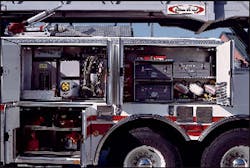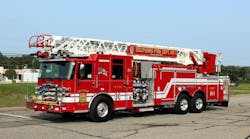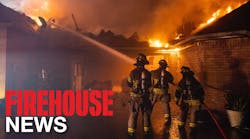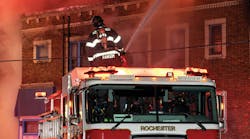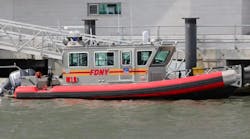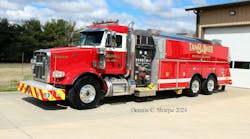In the past, many people considered factory or in-process inspections to be a perk awarded to the committee for its efforts and much of the time spent at the manufacturer's location was social and recreational in nature.
Now, to the contrary, pre-construction meetings and in-process inspections are important steps in the building process. They provide opportunities to respond to questions as well as clear up any misunderstandings as to the intent and wording in the specifications. For example, if the department specifications stated, "The crosslay hosebeds shall be as low to the ground as possible, but in no case shall be more than 64 inches from the ground," just what will be designed by the manufacturer?
Here are some guidelines to make the pre-construction conference more valuable :
- If you have not visited the manufacturer's facility, ask that the pre-construction meeting be held there. This lets the committee tour the plant where the apparatus will be built and meet some of the key personnel who will oversee the building process for your unit.
- Prior to the meeting, highlight the important items and components in your specification. Make sure to bring these items up during the meeting. It may be wise to prepare an agenda for this session to insure that all items are discussed, with the proposed resolution or person responsible to follow up on each issue that is discussed.
- Assign one member of the committee to take notes at the meeting and mark up one set of specifications and a blueprint to indicate what items were changed or relocated as a result of the discussions during the meeting.
- Limit the number of people who attend the pre-construction conference to four or five. Larger groups tend to wander from point to point through the specifications without a defined goal. Too few personnel often leads to "tunnel vision" with smaller items not reviewed and taken for granted.
Depending on the apparatus builder, this may be the last time in the process when the fire department can make any changes in the unit. If that is the case, you may want to consider another manufacturer.
It is one thing to look at blueprints and specifications; it is much different to see the vehicle in a pre-paint inspection. For example, one department's specifications required the vehicle to carry three pike poles/hooks. The manufacturer neatly configured a mounting bracket in the upper-right-hand corner of the hosebed that could hold three pike poles/hooks as specified, but then we noticed that the mounting bracket had enough room to accommodate three additional pike poles/hooks, as long as there was enough clearance behind the mounting bracket. So we asked the factory representative if we could add three more pike pole/hook spaces in the mounting bracket. He checked with engineering and found that it would work. We also were able to add an additional compartment based on our pre-paint inspection to use what other wise would have been wasted space. The changes did not cost much and made for a more functional vehicle.
The ability to make any change on the vehicle and its impact on cost and delivery time should be reviewed with the manufacturer, to prevent surprises or disappointments during the building process. If you have been following the concepts that we have outlined in the Apparatus Architect series, the apparatus committee members should all be on the same page with respect to the overall mission and conceptual design of the unit. The pre-construction conference is an opportunity to fine-tune the overall design of the apparatus.
We have all heard stories of major design flaws - for example, rigs that did not fit into stations on delivery or foam systems that did not work. Retaining the services of an apparatus architect will insure that major problems will not occur and that minor issues can be resolved easily, at times with less cost and improved performance. The overall investment of several hundred thousand dollars of taxpayer money can be well spent to provide safe and efficiently designed equipment by insuring that outside advice is secured before building a complex piece of apparatus.
Once the apparatus is being built, the department may elect to inspect the unit somewhere in the manufacturing process or at the point of final assembly. In-process inspection may be beneficial on more complex apparatus such as aerial devices and rescue trucks where certain components, once assembled, are difficult to inspect. In-process inspections can locate these components for mechanics and identify where critical parts are positioned.
If your department has elected to inspect the apparatus at the point of final assembly, there are several factors that the committee should consider. First, it is important to recognize that at this point in the manufacturing process few, if any, changes can be made on the apparatus. This is not the time to add warning lights to the cab roof or an additional rear discharge. Items such as tool and equipment mounting can normally be accommodated at this point so long as prior arrangements have been made with the manufacturer.
If the final inspection is being conducted at the manufacturer's facility, several items should be planned in advance of your trip. You should identify those items in your specifications that require verification of dimensions and sizes. ed during the inspection should also be identified. Finally, any performance requirements that were incorporated into the specifications should be listed to insure that each of these aspects is verified prior to final delivery and acceptance of the apparatus.
If your final inspection of the apparatus takes place at the dealer's location, some operational testing should be conducted at a local fire training center or other suitable location in the fire departments jurisdiction. Even if the dealer location has pump-testing facilities or the manufacturer has provided a pump certification, the pump must be tested.
Every pump delivered should under go an acceptance test as outlined in the National Fire Protection Association (NFPA) standards. Why? Here is an example. A fire department took delivery of a 1,250-gpm pumper. A firefighter from a neighboring town begged the fire department to do an acceptance test. The department finally complied. The 1,250-gpm pumper struggled to reach 720 gpm. After several trips to the factory, it was found that the transmission and pump were not assembled together properly, preventing the pump from reaching its capacity.
There is a lesson to be learned from this experience. All of the items on your checklist should be reviewed and verified by the apparatus committee. One concept that works well is to break down the apparatus specification into several areas, such as: chassis and frame, cab interior, cab exterior, pump and plumbing, body and compartments, and electrical systems. Each committee member can take several pages of the specification and inspect the completed apparatus against this document. This gets everyone involved with the inspection and will allow the committee to cover a lot of ground in a relatively short period.
No matter which method the committee utilizes to inspect the apparatus, you want to insure that everything required in the specification has been provided and that all equipment and components are operational. This part of the process should be rewarding in viewing the completed product with the guidance of a qualified representative from the apparatus manufacturer.
The next installment begins a focus on design features of different types of apparatus.
Tom Shand, a Firehouse